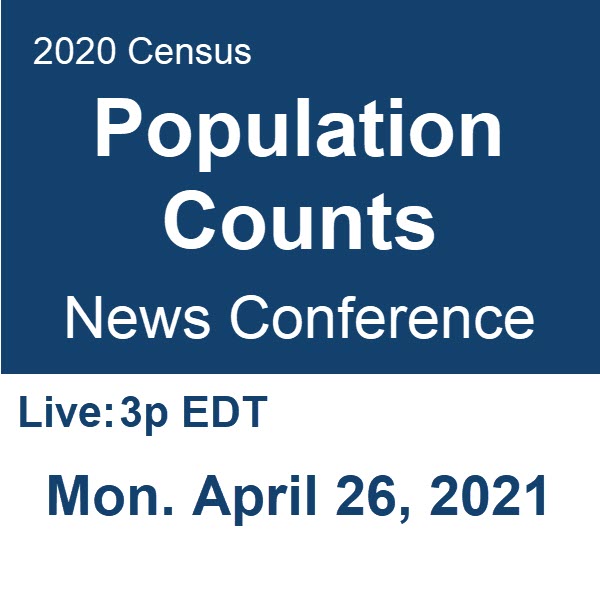State Population Totals Will Be Used for Congressional Apportionment
The first 2020 Census population counts will be released by the U.S. Census Bureau today. These counts will be used for apportionment, which is a process that determines how many seats in the U.S. House of Representatives each state will have for the next 10 years.
This first data release will include population totals for the United States, each of the 50 states, the District of Columbia and Puerto Rico. It will not provide counts for other geographies or population characteristics, all of which will be released later.
Article I, Section 2 of the U.S. Constitution mandates an apportionment of representatives among the states every 10 years, based on the state population counts from each decennial census.
The original purpose of the decennial census was apportionment, which is an integral part of our nation’s democratic process. Article I, Section 2 of the U.S. Constitution mandates an apportionment of representatives among the states every 10 years, based on the state population counts from each decennial census.
Congress has apportioned seats based on each decennial census from 1790 to 2020, except when members could not agree on how to reapportion seats after the 1920 Census.
What is the Apportionment Population?
The 2020 Census apportionment population count for each of the 50 states includes the state’s total resident population, plus a count of the overseas military and federal civilian employees — and their dependents living with them overseas — who have that state listed as their home state in their employers’ administrative records.
The populations of the District of Columbia and Puerto Rico are not included in the apportionment population because they do not have voting seats in the U.S. House of Representatives. However, resident population counts for those areas and the 50 states will be released at the same time as the apportionment population counts.
The populations of the U.S. Island Areas — American Samoa, Guam, the Commonwealth of the Northern Mariana Islands, the U.S. Virgin Islands — will not be included in this release but resident population counts for those areas will be released later.
For more details on who was counted (and where they were counted), see the Residence Criteria and Residence Situations for the 2020 Census.
Apportionment Resources
Several resources are now available on the Census Bureau’s website to help you learn about apportionment prior to the 2020 data release.
The video below describes the purpose and importance of apportionment. It also explains the apportionment process and how it’s calculated to ensure equal representation for all.
In addition, there is an Apportionment Fact Sheet that provides easily accessible and sharable information, as well as a blog that describes what to expect on the day of the apportionment release.
The Congressional Apportionment webpages provide helpful information and answers to frequently asked questions about apportionment, data from previous decades and details about the current and former methods for calculating apportionment:
Visualization
You can use the Historical Apportionment Data Map below to explore maps and charts showing apportionment and population data from 1910 to 2010.
Although the 2020 data are not yet available, you can already explore historical data for 11 decades. On the left-hand side of the tool, you can click on a year to view data for that decade.
Click the “Apportionment Map” button (at the top of the tool) to view either the change in seats or congressional representation. And click the “Population Map” button to view either population change or population density.
Hover over a specific state within each map to see a pop-up of that state’s data. You can also click on a state or select from a drop-down menu to display historical information about that state in the charts below each map.
Data from the 2020 Census will be added to the Historical Apportionment Data Map within a week after the apportionment release.
What Will the 2020 Census Apportionment Release Include?
The 2020 Census apportionment data tables will be available on the press kit webpage immediately following our press conference today.
There will be three data tables in the press kit:
- Apportionment Population and Number of Representatives by State: 2020 Census.
- Resident Population for the 50 States, the District of Columbia, and Puerto Rico: 2020 Census.
- Overseas Population for the 50 States and the District of Columbia: 2020 Census.
The apportionment data release will only include population counts at the state level. It will not include population counts for specific counties, cities or towns, and will not include any information about demographic characteristics like age, sex, race or Hispanic origin. We will release these data at a later date.
Other related items will be added to the apportionment press kit webpage on the day of the release, including three maps, another America Counts story (highlighting apportionment results), and a Director’s Blog.
The three maps in the press kit will be:
- Apportionment of the U.S. House of Representatives Based on the 2020 Census (see 2010 version of this map).
- 2020 Resident Population for the 50 States, the District of Columbia, and Puerto Rico.
- Percent Change in Resident Population for the 50 States, the District of Columbia, and Puerto Rico: 2010 to 2020.
Within days after the apportionment release, a set of supplemental tables will be published on a new 2020 Census Apportionment Results webpage that will be linked to the apportionment press kit webpage.
These tables will include additional data on the apportionment population and its components, as well as historical changes in the number of seats each state has in the House of Representatives.
Alysia Blake is a statistician and an apportionment project analyst at the Census Bureau.
Kristin Koslap is a statistician and the senior technical expert for apportionment at the Census Bureau.
Story Ideas and Statistics
-
Director's BlogThe 2020 Census: Our Growing NationThe U.S. Census Bureau released results from the 2020 Census, marking the 24th time the nation’s population has been counted.
-
Random Samplings BlogApportionment Population Counts and What to Expect on Release DayHere at the U.S. Census Bureau, we’re excited to be nearing the important milestone of delivering the first results from the 2020 Census — the apportionment population counts.
-
Random Samplings BlogHow Apportionment is CalculatedIn this blog, we will talk about how we calculate the apportionment of seats in the U.S. House of Representatives.
Subscribe
Our email newsletter is sent out on the day we publish a story. Get an alert directly in your inbox to read, share and blog about our newest stories.
Contact our Public Information Office for media inquiries or interviews.
-
America Counts StoryCensus Shares Population Estimates for Evaluation of Upcoming ResultsDecember 15, 2020Demographic Analysis uses current and historical vital records, international migration data and Medicare records...
-
America Counts StoryDemographic Analysis Shows Population Estimates as of April 1, 2020December 09, 2020Independent estimates will help assess the accuracy of the 2020 Census. Demographic Analysis uses vital and Medicare records and international migration data.
-
America Counts Story2020 Census Is Critical for Your CommunityMay 13, 2020Your community can extend far beyond where you live. It can be made up of people with the same interests or professions.
-
Business and EconomyState Governments Parlay Sports Betting Into Tax WindfallDecember 10, 2025Total state-level sports betting tax revenues has increased 382% since the third quarter of 2021, when data collection began.
-
EmploymentU.S. Workforce is Aging, Especially in Some FirmsDecember 02, 2025Firms in sectors like utilities and manufacturing and states like Maine are more likely to have a high share of workers over age 55.
-
PopulationTribal Casinos: An Economic BoonNovember 20, 2025A new study explores how tribal casino expansion in the 1990s and 2000s affected poverty, jobs and income for American Indian communities and their neighbors.
-
NAICS Sector 31-33 ManufacturingSome Less Populous States Have High Manufacturing Revenue Per CapitaSeptember 29, 2025Today is the start of a week of celebrations at the Census Bureau marking the 14th annual Manufacturing Day on October 3.





